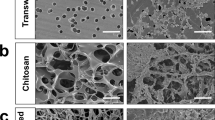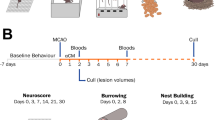Abstract
Adult neural progenitor cells (NPCs) induce post-ischemic long-term neuroprotection and brain remodeling by releasing of survival- and plasticity-promoting mediators. To evaluate whether secreted factors may mimic neuroprotective and restorative effects of NPCs, we exposed male C57BL6 mice to focal cerebral ischemia and intravenously applied conditioned medium (CM) derived from subventricular zone NPCs. CM dose-dependently reduced infarct volume and brain leukocyte infiltration after 48 h when delivered up to 12 h after focal cerebral ischemia. Neuroprotection persisted in the post-acute stroke phase yielding enhanced neurological recovery that lasted throughout the 28-day observation period. Increased Bcl-2, phosphorylated Akt and phosphorylated STAT-3 abundance, and reduced caspase-3 activity and Bax abundance were noted in ischemic brains of CM-treated mice at 48 h post-stroke, indicative of enhanced cell survival signaling. Long-term neuroprotection was associated with increased brain glial cell line-derived neurotrophic factor (GDNF) and vascular endothelial growth factor (VEGF) concentrations at 28 days resulting in increased neurogenesis and angiogenesis. The observation that NPC-derived CM induces sustained neuroprotection and neurological recovery suggests that cell transplantation may be dispensable when secreted factors are instead administered.





Similar content being viewed by others
References
Butti E, Cusimano M, Bacigaluppi M, Martino G (2014) Neurogenic and non-neurogenic functions of endogenous neural stem cells. Front Neurosci 8:92. doi:10.3389/fnins.2014.00092
Vishwakarma SK, Bardia A, Tiwari SK, Paspala SA, Khan AA (2014) Current concept in neural regeneration research: NSCs isolation, characterization and transplantation in various neurodegenerative diseases and stroke: a review. J Adv Res 5(3):277–294. doi:10.1016/j.jare.2013.04.005
Arvidsson A, Collin T, Kirik D, Kokaia Z, Lindvall O (2002) Neuronal replacement from endogenous precursors in the adult brain after stroke. Nat Med 8(9):963–970
Hermann DM, Peruzzotti-Jametti L, Schlechter J, Bernstock JD, Doeppner TR, Pluchino S (2014) Neural precursor cells in the ischemic brain—integration, cellular crosstalk, and consequences for stroke recovery. Front Cell Neurosci 8:291. doi:10.3389/fncel.2014.00291
Kalladka D, Muir KW (2014) Brain repair: cell therapy in stroke. Stem Cells Cloning: Adv Appl 7:31–44. doi:10.2147/SCCAA.S38003
Jin K, Wang X, Xie L, Mao XO, Greenberg DA (2010) Transgenic ablation of doublecortin-expressing cells suppresses adult neurogenesis and worsens stroke outcome in mice. Proc Natl Acad Sci U S A 107(17):7993–7998. doi:10.1073/pnas.1000154107
Li B, Piao CS, Liu XY, Guo WP, Xue YQ, Duan WM, Gonzalez-Toledo ME, Zhao LR (2010) Brain self-protection: the role of endogenous neural progenitor cells in adult brain after cerebral cortical ischemia. Brain Res 1327:91–102. doi:10.1016/j.brainres.2010.02.030
Bacigaluppi M, Pluchino S, Peruzzotti Jametti L, Kilic E, Kilic U, Salani G, Brambilla E, West MJ et al (2009) Delayed post-ischaemic neuroprotection following systemic neural stem cell transplantation involves multiple mechanisms. Brain 132(Pt 8):2239–2251. doi:10.1093/brain/awp174
Darsalia V, Allison SJ, Cusulin C, Monni E, Kuzdas D, Kallur T, Lindvall O, Kokaia Z (2011) Cell number and timing of transplantation determine survival of human neural stem cell grafts in stroke-damaged rat brain. J Cereb Blood Flow Metab 31(1):235–242. doi:10.1038/jcbfm.2010.81
Doeppner TR, Ewert TA, Tonges L, Herz J, Zechariah A, Elali A, Ludwig AK, Giebel B et al (2012) Transduction of neural precursor cells with TAT-heat shock protein 70 chaperone: therapeutic potential against ischemic stroke after intrastriatal and systemic transplantation. Stem Cells 30(6):1297–1310. doi:10.1002/stem.1098
Doeppner TR, Kaltwasser B, Teli MK, Bretschneider E, Bahr M, Hermann DM (2014) Effects of acute versus post-acute systemic delivery of neural progenitor cells on neurological recovery and brain remodeling after focal cerebral ischemia in mice. Cell Death Dis 5, e1386. doi:10.1038/cddis.2014.359
Minnerup J, Kim JB, Schmidt A, Diederich K, Bauer H, Schilling M, Strecker JK, Ringelstein EB et al (2011) Effects of neural progenitor cells on sensorimotor recovery and endogenous repair mechanisms after photothrombotic stroke. Stroke; J Cereb Circ 42(6):1757–1763. doi:10.1161/STROKEAHA.110.599282
Tobin MK, Bonds JA, Minshall RD, Pelligrino DA, Testai FD, Lazarov O (2014) Neurogenesis and inflammation after ischemic stroke: what is known and where we go from here. J Cereb Blood Flow Metab 34(10):1573–1584. doi:10.1038/jcbfm.2014.130
Zhang R, Zhang Z, Zhang C, Zhang L, Robin A, Wang Y, Lu M, Chopp M (2004) Stroke transiently increases subventricular zone cell division from asymmetric to symmetric and increases neuronal differentiation in the adult rat. J Neurosci 24(25):5810–5815
Hermann DM, Chopp M (2012) Promoting brain remodelling and plasticity for stroke recovery: therapeutic promise and potential pitfalls of clinical translation. Lancet Neurol 11(4):369–380. doi:10.1016/S1474-4422(12)70039-X
Blum B, Benvenisty N (2008) The tumorigenicity of human embryonic stem cells. Adv Cancer Res 100:133–158. doi:10.1016/S0065-230X(08)00005-5
Blum B, Benvenisty N (2009) The tumorigenicity of diploid and aneuploid human pluripotent stem cells. Cell Cycle 8(23):3822–3830
Cho YJ, Song HS, Bhang S, Lee S, Kang BG, Lee JC, An J, Cha CI et al (2012) Therapeutic effects of human adipose stem cell-conditioned medium on stroke. J Neurosci Res 90(9):1794–1802. doi:10.1002/jnr.23063
Egashira Y, Sugitani S, Suzuki Y, Mishiro K, Tsuruma K, Shimazawa M, Yoshimura S, Iwama T et al (2012) The conditioned medium of murine and human adipose-derived stem cells exerts neuroprotective effects against experimental stroke model. Brain Res 1461:87–95. doi:10.1016/j.brainres.2012.04.033
Scheibe F, Klein O, Klose J, Priller J (2012) Mesenchymal stromal cells rescue cortical neurons from apoptotic cell death in an in vitro model of cerebral ischemia. Cell Mol Neurobiol 32(4):567–576. doi:10.1007/s10571-012-9798-2
Tate CC, Fonck C, McGrogan M, Case CC (2010) Human mesenchymal stromal cells and their derivative, SB623 cells, rescue neural cells via trophic support following in vitro ischemia. Cell Transplant 19(8):973–984. doi:10.3727/096368910X494885
Tsai MJ, Tsai SK, Hu BR, Liou DY, Huang SL, Huang MC, Huang WC, Cheng H et al (2014) Recovery of neurological function of ischemic stroke by application of conditioned medium of bone marrow mesenchymal stem cells derived from normal and cerebral ischemia rats. J Biomed Sci 21:5. doi:10.1186/1423-0127-21-5
Wei X, Du Z, Zhao L, Feng D, Wei G, He Y, Tan J, Lee WH et al (2009) IFATS collection: the conditioned media of adipose stromal cells protect against hypoxia-ischemia-induced brain damage in neonatal rats. Stem Cells (Dayton, Ohio) 27(2):478–488. doi:10.1634/stemcells.2008-0333
Kim SY, Cho HS, Yang SH, Shin JY, Kim JS, Lee ST, Chu K, Roh JK et al (2009) Soluble mediators from human neural stem cells play a critical role in suppression of T-cell activation and proliferation. J Neurosci Res 87(10):2264–2272. doi:10.1002/jnr.22050
Doeppner TR, Doehring M, Bretschneider E, Zechariah A, Kaltwasser B, Muller B, Koch JC, Bahr M et al (2013) MicroRNA-124 protects against focal cerebral ischemia via mechanisms involving Usp14-dependent REST degradation. Acta Neuropathol 126(2):251–265. doi:10.1007/s00401-013-1142-5
Doeppner TR, Kaltwasser B, Bahr M, Hermann DM (2014) Effects of neural progenitor cells on post-stroke neurological impairment—a detailed and comprehensive analysis of behavioral tests. Front Cell Neurosci 8:338. doi:10.3389/fncel.2014.00338
Chu HX, Kim HA, Lee S, Moore JP, Chan CT, Vinh A, Gelderblom M, Arumugam TV et al (2014) Immune cell infiltration in malignant middle cerebral artery infarction: comparison with transient cerebral ischemia. J Cereb Blood Flow Metab 34(3):450–459. doi:10.1038/jcbfm.2013.217
Doeppner TR, Bretschneider E, Doehring M, Segura I, Senturk A, Acker-Palmer A, Hasan MR, Elali A et al (2011) Enhancement of endogenous neurogenesis in ephrin-B3 deficient mice after transient focal cerebral ischemia. Acta Neuropathol 122(4):429–442. doi:10.1007/s00401-011-0856-5
Rosell A, Morancho A, Navarro-Sobrino M, Martinez-Saez E, Hernandez-Guillamon M, Lope-Piedrafita S, Barcelo V, Borras F et al (2013) Factors secreted by endothelial progenitor cells enhance neurorepair responses after cerebral ischemia in mice. PLoS One 8(9), e73244. doi:10.1371/journal.pone.0073244
Dao M, Tate CC, McGrogan M, Case CC (2013) Comparing the angiogenic potency of naive marrow stromal cells and Notch-transfected marrow stromal cells. J Transl Med 11:81. doi:10.1186/1479-5876-11-81
Hsieh JY, Wang HW, Chang SJ, Liao KH, Lee IH, Lin WS, Wu CH, Lin WY et al (2013) Mesenchymal stem cells from human umbilical cord express preferentially secreted factors related to neuroprotection, neurogenesis, and angiogenesis. PLoS One 8(8), e72604. doi:10.1371/journal.pone.0072604
Yoo SW, Chang DY, Lee HS, Kim GH, Park JS, Ryu BY, Joe EH, Lee YD et al (2013) Immune following suppression mesenchymal stem cell transplantation in the ischemic brain is mediated by TGF-beta. Neurobiol Dis 58:249–257. doi:10.1016/j.nbd.2013.06.001
Yoo SW, Kim SS, Lee SY, Lee HS, Kim HS, Lee YD, Suh-Kim H (2008) Mesenchymal stem cells promote proliferation of endogenous neural stem cells and survival of newborn cells in a rat stroke model. Exp Mol Med 40(4):387–397
Zheng W, Honmou O, Miyata K, Harada K, Suzuki J, Liu H, Houkin K, Hamada H et al (2010) Therapeutic benefits of human mesenchymal stem cells derived from bone marrow after global cerebral ischemia. Brain Res 1310:8–16. doi:10.1016/j.brainres.2009.11.012
Lee RH, Pulin AA, Seo MJ, Kota DJ, Ylostalo J, Larson BL, Semprun-Prieto L, Delafontaine P et al (2009) Intravenous hMSCs improve myocardial infarction in mice because cells embolized in lung are activated to secrete the anti-inflammatory protein TSG-6. Cell Stem Cell 5(1):54–63. doi:10.1016/j.stem.2009.05.003
Lee ST, Chu K, Jung KH, Kim SJ, Kim DH, Kang KM, Hong NH, Kim JH et al (2008) Anti-inflammatory mechanism of intravascular neural stem cell transplantation in haemorrhagic stroke. Brain 131(Pt 3):616–629. doi:10.1093/brain/awm306
Lees KR, Bluhmki E, von Kummer R, Brott TG, Toni D, Grotta JC, Albers GW, Kaste M et al (2010) Time to treatment with intravenous alteplase and outcome in stroke: an updated pooled analysis of ECASS, ATLANTIS, NINDS, and EPITHET trials. Lancet 375(9727):1695–1703. doi:10.1016/S0140-6736(10)60491-6
Li T, Yan Y, Wang B, Qian H, Zhang X, Shen L, Wang M, Zhou Y et al (2013) Exosomes derived from human umbilical cord mesenchymal stem cells alleviate liver fibrosis. Stem Cells Dev 22(6):845–854. doi:10.1089/scd.2012.0395
Lee C, Mitsialis SA, Aslam M, Vitali SH, Vergadi E, Konstantinou G, Sdrimas K, Fernandez-Gonzalez A et al (2012) Exosomes mediate the cytoprotective action of mesenchymal stromal cells on hypoxia-induced pulmonary hypertension. Circulation 126(22):2601–2611. doi:10.1161/CIRCULATIONAHA.112.114173
Hermann DM, Zechariah A (2009) Implications of vascular endothelial growth factor for postischemic neurovascular remodeling. J Cereb Blood Flow Metab 29(10):1620–1643. doi:10.1038/jcbfm.2009.100
Ma Y, Zechariah A, Qu Y, Hermann DM (2012) Effects of vascular endothelial growth factor in ischemic stroke. J Neurosci Res 90(10):1873–1882. doi:10.1002/jnr.23088
Pavlichenko N, Sokolova I, Vijde S, Shvedova E, Alexandrov G, Krouglyakov P, Fedotova O, Gilerovich EG et al (2008) Mesenchymal stem cells transplantation could be beneficial for treatment of experimental ischemic stroke in rats. Brain Res 1233:203–213. doi:10.1016/j.brainres.2008.06.123
Acknowledgments
The present study was supported by TUBITAK (#2221; to TRD) and the German Research Council (HE3173/2-2 and HE3173/3-1; to DMH).
Author information
Authors and Affiliations
Corresponding author
Ethics declarations
Conflict of interest/disclosures
BB got a travel grant and a speaker honorary from CSL Behring (Germany) and material supports of CSL Behring (Germany and Canada). As a member of the scientific advisory board of Edge Therapeutics, Inc., BB received advisor honorary. The other authors declare no conflict of interest.
Electronic supplementary material
Below is the link to the electronic supplementary material.
ESM 1
(PDF 114 kb)
Rights and permissions
About this article
Cite this article
Doeppner, T.R., Traut, V., Heidenreich, A. et al. Conditioned Medium Derived from Neural Progenitor Cells Induces Long-term Post-ischemic Neuroprotection, Sustained Neurological Recovery, Neurogenesis, and Angiogenesis. Mol Neurobiol 54, 1531–1540 (2017). https://doi.org/10.1007/s12035-016-9748-y
Received:
Accepted:
Published:
Issue Date:
DOI: https://doi.org/10.1007/s12035-016-9748-y




